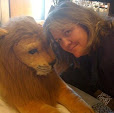
I'm on a Tracy Chevalier roll lately. I listened to The Lady and the Unicorn and blogged on it recently, and just finished listening to her latest, Remarkable Creatures, which is a fictionalized account of the lives, work, and relationship of Mary Anning and Elizabeth Philpot. These two women were truly as remarkable as the remains of the creatures they found, and I loved reading their stories as told by themselves.
Mary was a poor working girl who lived a stone's throw from the beach at Lyme Regis in the early 1800s. Elizabeth was a London-bred spinster, about ten to fifteen years her senior, who retired with her sisters to Lyme Regis when their parents died and their brother married. Mary grew up finding "curies"--that is, fossils of ancient, extinct creatures--on the beach and in the cliffs rising out of the beach near her home. She sold them mostly to the scientific "gentlemen" who were actively formulating the theories related to geology, evolution, the age of the earth, and God and his handiwork that would shake, rattle, and roll society, education, and theology.
Elizabeth was Mary's friend--a single lady, living with her sisters, in a style comparable to the Austen sisters, though they weren't quite as dependent on the kindness of brothers as Jane and Cassandra were. They shared a passion for fossils, and Elizabeth helped Mary's family figure out how to sell her incredible finds (e.g., the first complete ichthyosaurus and the first plesiosaurus).
I'm planning on reading The Fossil Hunter, by Shelley Emling, which is a non-fictional approach to the same subject. I'm glad I learned about Mary and Elizabeth in novel form first, however, because Chevalier did such a terrific job of shaping the themes and balancing the struggles the women faced (i.e., with each other, society, and the men who patronized them) in the context of each's own voice. It was well-written, cohesive, and, above all, terribly interesting.

The entire novel is in first person, though sometimes Mary is speaking and sometimes Elizabeth is. I'm not sure if the distinction between the two voices comes through as strongly in print as it does in audio form, but the two readers were so distinct--Elizabeth with her gentrified voice and Mary with her working class speech that I came away feeling that I knew each woman very well and could empathize with them completely. I loved how Elizabeth, the observer, always introduced the people with what they "led with"--their eyes, their feet, their mouth, their hands--it was an effective thread that gave me insight into both Elizabeth and the people she encountered. I loved how Mary's defining characteristic was that she was struck by lightening--literally and figuratively. Chevalier was really in top form with this book.
As a long-time reader of Austen, I have found that over the years my interest in her life and times has extended in particular to the scientific progress that was happening during the Regency and beyond. Remarkable Creatures provided a wonderful slice of life during the time period immediately following her death. In addition, I felt that I had a realistic view into various strata of society and how they interacted with each and how they didn't.
I must say, though, that the only clumsy part was when Chevalier felt the need to insert Austen into the story--Elizabeth, who has a keen scientific mind, denigrates her younger sister Margaret, who, she feels, wastes her time reading romantic novels such as those by Miss Austen who Margaret sort of remembers meeting at an assembly shortly after the Philpot sisters moved to Lyme. I found this pandering to the common infatuation with Austen a bit grating, but it really was the only less than fabulous part of the novel.
Definitely one of the best books I've read in 2010 thus far.

Hi Jane, Got here thrpugh MG's Fligh High blog. I've also just finished reading "Remarkable Creatures" and loved it. I'm actually a long lasting fan of Tracy Chevalier's since The Virgin Blue (which is my favourite, by the way!). I was very disappointed by Burning Bright but with Remarkable Creatures Tracy seems to be back "on the saddle". I wasn't very keen on the Jane Austen part either, but in the postscript Tracy tells that JA actually visited Lyme Regis in 1804 and did meet Richard Anning, so there is no reason why she and Margaret Philpot could not have been n the Assembly Rooms at the same time. Wish you all the best. Ciao. A.
ReplyDeleteThis one sounds really good! I'm definitely putting it on my ever-expanding 'To read' list. Thanks, Jane!
ReplyDeleteThanks for the rec. Been sitting on the fence about this one. (Teresa AF)
ReplyDeleteOk! I've just made up my mind: I MUST READ IT! Thank you, Jane. (And A.!)
ReplyDeleteI really must get my hands on this one soon!
ReplyDeleteWell, I bought a copy last week, and as soon as I've finished reading my current bookclub choices (2.5 down, 2 to go), it's next on the list - thanks for the recommendation!
ReplyDeleteI've just finished this book, and written up my own review on my blog.
ReplyDelete--Elizabeth, who has a keen scientific mind, denigrates her younger sister Margaret, who, she feels, wastes her time reading romantic novels such as those by Miss Austen
I thought that was OK - Jane Austen's novels are exactly the kind I can imagine the excessively Romantic Margaret reading - Louise has her plants, Elizabeth her fossils, and Margaret? She just has her memories of what might have been.